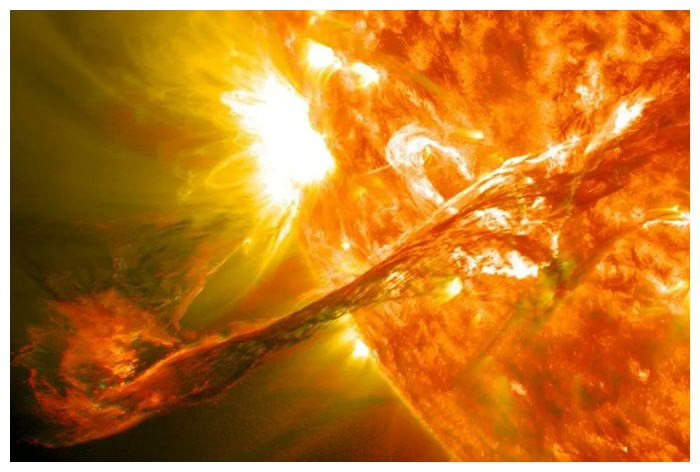
[ad_1]
A ‘cannibal’ coronal mass ejection is heading towards Earth and could cause a strong solar storm today, warned NOAA (National Oceanic and Atmospheric Administration). On August 5, an X1.6-class solar flare erupting from the Sun released two powerful CMEs.

Cannibal Solar Explosion Likely To Hit Earth Today: The National Oceanic and Atmospheric Administration (NOAA) has issued a warning about a “cannibal’ coronal mass ejection” (CME) that is heading towards Earth. The NOAA has said that the CME could cause a “strong solar storm today.” On August 5, an X1.6-class solar flare erupting from the Sun released two powerful CMEs. These two CME clouds have combined, with the second one overtaking the first, creating a cannibal CME. The X1.6-class solar flare released two powerful coronal mass ejections (CMEs) on August 5 and now they have become “even more terrifying”.
Merger Of Two CME Clouds
The two CME clouds have merged, with the second, faster one, overtaking and cannibalizing the first, said a new NOAA model adding that the merged entity has become even more powerful. Even a glancing blow from such a cloud can spark a vicious solar storm. The latest forecast says the storm will hit the Earth later today, August 8, and can produce G3-class storms, says tech.hindustantimes.com.
What Are Coronal Mass Ejections
Coronal mass ejections (CMEs) are large, fast-moving clouds of magnetized plasma and solar radiation that occasionally get flung into space alongside solar flares — powerful explosions on the sun’s surface that are triggered when horseshoe-shaped loops of plasma located near sunspots snap in half like an overstretched elastic band. If CMEs smash into Earth, they can cause geomagnetic storms — disturbances in our planet’s magnetic field — that can trigger partial radio blackouts and produce vibrant aurora displays much farther away from Earth’s magnetic poles than normal, says space.com.
Cannibal CME
A cannibal CME is created when an initial CME is followed by a second faster one. When the second CME catches up to the first cloud, it engulfs it, creating a single, massive wave of plasma, says space.com.
Two CMEs Left The Sun On August 5
“A new NOAA model shows the two CMEs leaving the sun on Aug. 5th, then merging to form a single ‘cannibal CME’ that delivers a glancing blow to Earth on Aug. 8th. Cannibal CMEs are famous for causing strong geomagnetic storms, and even a glancing blow can be effective. In this case, storm levels could reach category G2 (Moderate) with a slight chance of escalating to G3 (Strong),” says a report by SpaceWeather.com.
Even though at the moment it is not confirmed whether the hit will be a head-on collision or a glancing blow, researchers are keeping a close eye on the cloud to keep abreast with every passing situation.
“A full-force strike can damage small satellites, impact mobile networks, and GPS, and even pose a threat to ground-based electronics and power grids by increasing the magnetic potential by huge amounts.
“Cannibal coronal mass ejections (CME) take place when speeding solar eruptions overtake earlier eruptions in the same region of space, combining with the charged particles to form a giant, combined wavefront that triggers a powerful geomagnetic storm. This always has a higher electromagnetic output and can cause significant damage to satellites and communication systems,” tech.hindustantimes.com adds further.
Things are not going to be quiet for Earth even after the solar storm passes over. Notably, AR3386, a departing sunspot, exploded yesterday, August 7 creating a powerful X1-class solar flare. It is uncertain at the moment whether the CME released during the flare eruption will strike the Earth though the extreme ultraviolet flash caused a shortwave radio blackout.
National Oceanic and Atmospheric Administration (NOAA)
The National Oceanic and Atmospheric Administration (NOAA) is a Washington, D.C.–based scientific and regulatory agency within the United States Department of Commerce, a United States federal government department. The agency is charged with forecasting the weather, monitoring oceanic and atmospheric conditions, charting the seas, conducting deep sea exploration, and managing fishing and protecting marine mammals and endangered species in the U.S. exclusive economic zone.
NOAA was formed on October 3, 1970, after U.S. President Richard Nixon proposed creating a new agency to serve a national need for “better protection of life and property from natural hazards… for a better understanding of the total environment… [and] for exploration and development leading to the intelligent use of our marine resources”.

Don’t Miss Out on the Latest Updates.
Subscribe to Our Newsletter Today!

[ad_2]